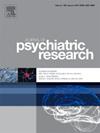Investigational transcranial magnetic stimulation measures as predictors of aggression in schizophrenia: A cross-sectional study
IF 3.2
2区 医学
Q1 PSYCHIATRY
引用次数: 0
Abstract
Background
Aggressive behaviors associated with schizophrenia are important determinants of the functional outcomes of the illness. Investigational transcranial magnetic stimulation (TMS) measures provide direct assessments of motor cortical inhibition, excitability, and plasticity, and these measures are known to be altered in individuals with schizophrenia. This study aimed to examine the association between these TMS measures and aggressive behavior in individuals with schizophrenia.
Methods
79 minimally treated patients with a diagnosis of schizophrenia as per DSM-5 were recruited for the study from Central Institute of Psychiatry, India. Short Interval Cortical Inhibition (SICI), Long Interval Cortical Inhibition (LICI), Cortical Silent Period (CSP), a proxy measure of recruitment gain (SI1mV - RMT), and measures of cortical plasticity were recorded, along with basic clinical data. The Modified Overt Aggression Scale (MOAS) was used to quantify total aggression scores.
Results
CSP (R = 0.322, p = 0.004), SICI (R = −0.33, p = 0.003) and SI1mV - RMT (R = 0.367, p = 0.0008) were significantly correlated with total MOAS scores. A multivariate linear regression model including CSP, SICI, and SI1mV - RMT explained 17 % of the variance in total MOAS scores (p = 0.0036, Cohen's f2 = 0.2), indicating moderate predictive utility for clinical risk assessment. A multivariate logistic regression model with the same predictors achieved an AUC of 0.704 (p = 0.005) in distinguishing high aggressors (total MOAS score ≥10) from low aggressors. Despite the overall model being significant, none of the individual predictors reached statistical significance, suggesting possible interaction effects that warrant further exploration. Including other TMS measures and various clinical and sociodemographic variables did not improve the model fit.
Conclusion
TMS measures of cortical inhibition (SICI, CSP) and excitability (SI1mV - RMT) provide neurophysiological biomarkers for predicting aggressive behaviour in schizophrenia. This can potentially enable clinicians to identify high-risk patients for targeted interventions. Cross sectional design and moderate sample size are important limitations of the study.
经颅磁刺激作为精神分裂症患者攻击行为的预测指标:一项横断面研究。
背景:与精神分裂症相关的攻击行为是疾病功能结局的重要决定因素。研究性经颅磁刺激(TMS)测量提供了对运动皮质抑制、兴奋性和可塑性的直接评估,而这些测量已知在精神分裂症患者中会发生改变。本研究旨在研究这些经颅磁刺激测量与精神分裂症患者攻击行为之间的关系。方法:从印度中央精神病学研究所招募79名根据DSM-5诊断为精神分裂症的最低限度治疗患者进行研究。记录短间隔皮质抑制(SICI)、长间隔皮质抑制(LICI)、皮质沉默期(CSP)、招募增益(SI1mV - RMT)和皮质可塑性测量,并记录基本临床数据。采用改良外显攻击量表(MOAS)对攻击总分进行量化。结果:CSP (R = 0.322, p = 0.004)、SICI (R = -0.33, p = 0.003)、SI1mV - RMT (R = 0.367, p = 0.0008)与MOAS总分呈显著相关。包括CSP、SICI和SI1mV - RMT在内的多元线性回归模型解释了总MOAS评分方差的17% (p = 0.0036, Cohen's f2 = 0.2),表明临床风险评估的预测效用中等。具有相同预测因子的多变量logistic回归模型在区分高攻击者(MOAS总分≥10)和低攻击者方面的AUC为0.704 (p = 0.005)。尽管整体模型是显著的,但没有一个个体预测因子达到统计显著性,这表明可能的相互作用值得进一步探索。包括其他经颅磁刺激测量和各种临床和社会人口变量并没有改善模型拟合。结论:经颅电刺激测量皮层抑制(SICI, CSP)和兴奋性(SI1mV - RMT)为预测精神分裂症患者的攻击行为提供了神经生理生物标志物。这可能使临床医生能够识别高危患者进行有针对性的干预。横断面设计和适度的样本量是研究的重要局限性。
本文章由计算机程序翻译,如有差异,请以英文原文为准。
求助全文
约1分钟内获得全文
求助全文
来源期刊

Journal of psychiatric research
医学-精神病学
CiteScore
7.30
自引率
2.10%
发文量
622
审稿时长
130 days
期刊介绍:
Founded in 1961 to report on the latest work in psychiatry and cognate disciplines, the Journal of Psychiatric Research is dedicated to innovative and timely studies of four important areas of research:
(1) clinical studies of all disciplines relating to psychiatric illness, as well as normal human behaviour, including biochemical, physiological, genetic, environmental, social, psychological and epidemiological factors;
(2) basic studies pertaining to psychiatry in such fields as neuropsychopharmacology, neuroendocrinology, electrophysiology, genetics, experimental psychology and epidemiology;
(3) the growing application of clinical laboratory techniques in psychiatry, including imagery and spectroscopy of the brain, molecular biology and computer sciences;
 求助内容:
求助内容: 应助结果提醒方式:
应助结果提醒方式:


